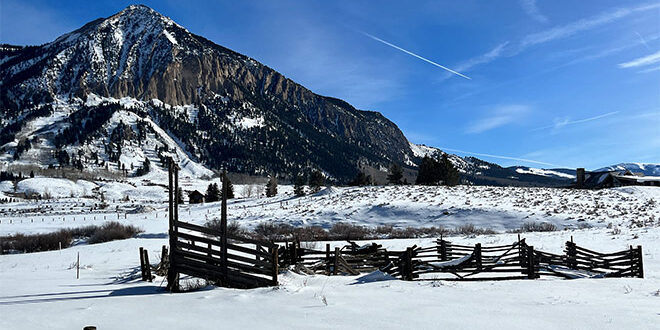Inflation reducing size of fire station and S-and-R building
[ by Mark Reaman ]
The Crested Butte Fire Protection District (CBFPD) is dealing with the reality that time is money. While sufficient property along Gothic Road near the Crested Butte Cemetery was secured earlier this month for a new safety campus, inflation along with rapidly increasing construction prices are eating into what was expected to be built. As CBFPD chief executive officer Sean Caffrey said this week: “Our hopes for a 100-year station with room for growth built in have mostly been dashed due to price escalation.”
Voters approved a bond issue in 2021 that gave the green light to the CBFPD to borrow up to $25.95 million to build a new fire station and Search-and-Rescue campus that included workforce housing, but final plans have not been finalized and no construction has started. The fire district had originally anticipated building an approximately 33,000 square foot fire station and a 10,000 square foot Search-and-Rescue headquarters along with a four-plex for employee housing. The initial idea was to use town-owned land in Crested Butte’s Slate River subdivision located near the Aperture development. But a kerfuffle over some town council requirements for the free property resulted in the CBFPD walking away from the offer. Instead, the district moved on to purchase land from the Spann Ranches that is directly adjacent to the original town lot in front of the Crested Butte Cemetery. Gunnison County now has regulatory authority over the development.
Caffrey confirmed that the CBFPD officially closed on the last of two pieces of the Spann family property on December 9. The total land costs for the two parcels was $2.5 million and that came out of the bond funds. The property is split by the Slate River with about 4.2 acres on the west side of the river closer to Crested Butte.
“We now own 7.5 acres along Gothic Road, and we are working on site planning now,” he said. “We intend to ask the Town of Crested Butte about extraterritorial water and sewer connections, however, we don’t have enough of a site plan yet to make that submission.”
Caffrey said that the delay in the construction start along with price differences are impacting what will eventually be built. “The price estimates are increasing,” Caffrey said. “So, we are now looking at a Search-and-Rescue building in the 5,500 to 6,000 square foot range and a fire headquarters in the 22,000 square foot range. Those numbers may change somewhat as we dial in what the sitework costs will be.”
He said an initial review is pointing toward the elimination of a maintenance bay, a few bedrooms for overnight responders and several meeting and office spaces as the main targets for reduction in the facilities.
As for the employee housing, Caffrey said that element of the proposed project is also being impacted by rising costs and inflation. “We’ll be doing housing off-site,” he explained. “We’re not sure of the budget remaining for that yet as we will need to prioritize the public safety buildings.”
In the meantime, the money from the bond issue is gathering interest which Caffrey said will be helpful for the project. “We won’t have a good sense of the interest number until we can get the accountants to help us reconcile the numbers,” he noted. “I can tell you we have various amounts invested at rates between 1% and 5% with the latest reinvestments being closer to 5%. By the time we start we should have a few hundred thousand dollars in interest proceeds.”
Caffrey said the district is expected to make official planning review submissions to Gunnison County by February. The request for Crested Butte water and sewer service would be made about the same time.
Fee increases
Meanwhile, Caffrey said the district increased its fire prevention fees earlier this year. The goal was to have growth pay its own way while ensuring small projects would not be adversely impacted.
“The fees are now inclusive of most plan reviews and inspections and are based on square footage. They are skewed toward keeping smaller projects economical,” he explained. “We previously had a flatter fee structure regardless of size that wasn’t reflective of the workload for larger projects. Like other local governments we’ve tried to set the fees to offset our costs which currently include 3.4 staff members who cover reviews and inspections for our 220 square miles across three jurisdictions.”
The new fees were approved by the board in February of 2022 and went into effect in April.
 The Crested Butte News Serving the Gunnison Valley since 1999
The Crested Butte News Serving the Gunnison Valley since 1999



